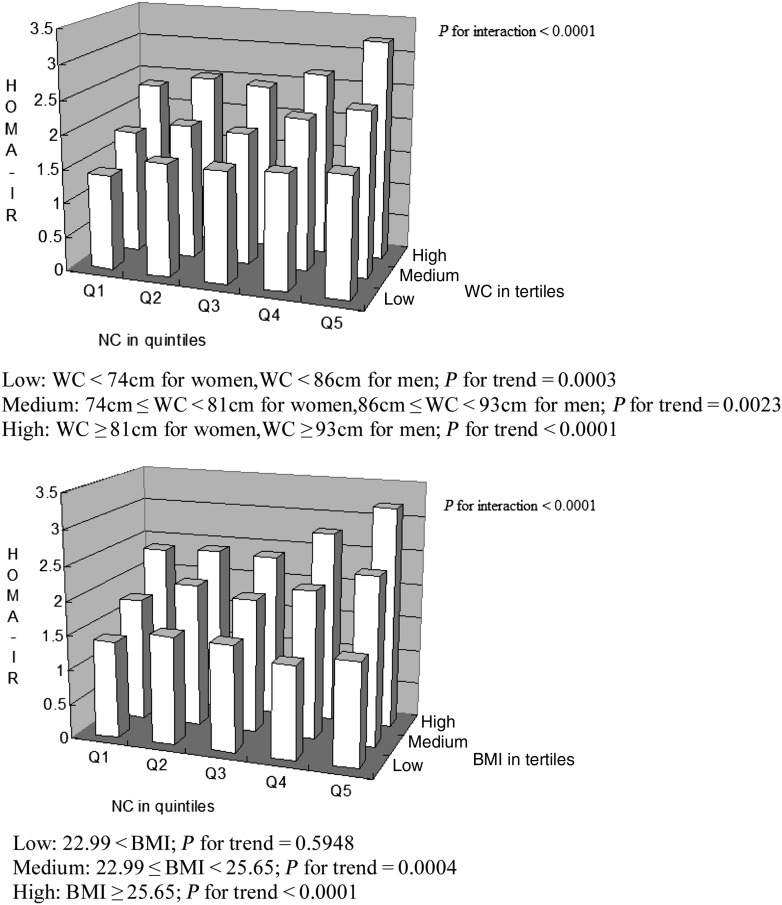Neck circumference (NC) is a proxy for upper-body fat and a reliable screening measure for the identification of individuals with abnormal fat distribution. Recently, compelling evidence indicates that NC is positively associated with insulin resistance (IR) and a variety of cardiometabolic abnormalities, independent of overall adiposity and central obesity in Caucasians (1) or Chinese diabetic patients (2). However, it remains unknown whether NC affects IR in the general Chinese population.
In the current study, we analyzed the associations of NC with IR and cardiometabolic risk factors in 2,588 apparently healthy Chinese adults (20–87 years of age) from the Cardiometabolic Risk in Chinese (CRC) study (3). We found a significant association between NC and an increasing trend of homeostasis model assessment of insulin resistance (HOMA-IR), adjusting for age and other cardiometabolic risk factors, in both men (P = 0.02) and women (P = 0.004). The differences in HOMA-IR between the extreme quintiles of NC appeared more evident in men than in women; however, the test for the heterogeneity between men and women was not significant. Further adjustment for BMI and waist circumference (WC) did not appreciably change the associations between NC and IR. In addition, high NC was significantly related to a decreasing trend of HDL levels in both sexes and was significantly related to an increasing trend of plasma triglyceride and uric acid levels only in men (P for sex difference <0.03), after adjustment for covariates including BMI or WC and HOMA-IR.
We also found significant interactions of NC with BMI and WC (P for interaction <0.0001) in relation to HOMA-IR (Fig. 1). It appears that the associations between NC and HOMA-IR were more evident in those with a higher BMI or WC.
Figure 1.
The joint effect of NC (in quintiles) with WC and BMI (low, medium, and high levels) on HOMA-IR.
To our knowledge, the current study is among the first to assess the associations of NC with IR and metabolic risk in a general population of Chinese adults. Our findings are in line with the results from several previous studies in Caucasians and Chinese diabetic patients (1,2). In the Framingham Study, it was found that NC was associated with IR and cardiovascular risk factors in a sex-specific manner (1). It has been documented that high NC was a significant predictor of obstructive sleep apnea syndrome (4), which has been associated with risk of IR and diabetes. Obstructive sleep apnea syndrome aggravates glycemic control, even at the earliest stages of glucose intolerance. In addition, intermittent hypoxemia and sleep fragmentation increase the risk of IR (5). Our data, together with evidence from other studies, suggest that body fat accumulated in the upper body segment may contribute to the adverse metabolic consequence.
In conclusion, we found significant associations of high NC with increased risk of IR and a variety of cardiometabolic risk factors in apparently healthy Chinese adults, and found sexual dimorphism for associations with certain risk factors. Our findings support a recommendation for the inclusion of NC in the routine clinical assessment of adults to identify those at high risk of cardiometabolic diseases such as type 2 diabetes and heart disease.
Acknowledgments
L.Q.’s research is supported by National Institutes of Health grants DK-091718 and HL-071981, the American Heart Association Scientist Development Award, and the Boston Obesity Nutrition Research Center (DK-46200). J.L.’s research was sponsored by Jiangsu Health International Exchange Program and supported by a Xuzhou medical leading talent grant and Xuzhou Science and Technology Board Foundation grant (XF11C067).
No potential conflicts of interest relevant to this article were reported.
J.L. wrote and reviewed the manuscript. F.T. wrote the manuscript. Y.L. and X.L. performed statistical analyses. C.Z. and Y.W. contributed to discussion. H.L. edited the manuscript. L.Q. researched data and wrote the manuscript. L.Q. is the guarantor of this work and, as such, had full access to all the data in the study and takes responsibility for the integrity of the data and the accuracy of the data analysis.
The authors thank all subjects for participating in this study.
References
- 1.Preis SR, Massaro JM, Hoffmann U, et al. Neck circumference as a novel measure of cardiometabolic risk: the Framingham Heart study. J Clin Endocrinol Metab 2010;95:3701–3710 [DOI] [PMC free article] [PubMed] [Google Scholar]
- 2.Yang GR, Yuan SY, Fu HJ, et al. Beijing Community Diabetes Study Group Neck circumference positively related with central obesity, overweight, and metabolic syndrome in Chinese subjects with type 2 diabetes: Beijing Community Diabetes Study 4. Diabetes Care 2010;33:2465–2467 [DOI] [PMC free article] [PubMed] [Google Scholar]
- 3.Liang J, Zhou N, Teng F, et al. Hemoglobin A1c levels and aortic arterial stiffness: the Cardiometabolic Risk in Chinese (CRC) study. PLoS ONE 2012;7:e38485. [DOI] [PMC free article] [PubMed] [Google Scholar]
- 4.Onat A, Hergenç G, Yüksel H, et al. Neck circumference as a measure of central obesity: associations with metabolic syndrome and obstructive sleep apnea syndrome beyond waist circumference. Clin Nutr 2009;28:46–51 [DOI] [PubMed] [Google Scholar]
- 5.Steiropoulos P, Papanas N, Bouros D, Maltezos E. Obstructive sleep apnea aggravates glycemic control across the continuum of glucose homeostasis. Am J Respir Crit Care Med 2010;182:286. [DOI] [PubMed] [Google Scholar]



